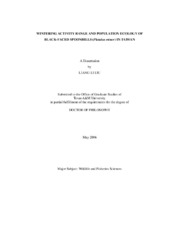| dc.description.abstract | Black-faced Spoonbill (BFS), Platalea minor, numbers during the non-breeding season increased steadily from 1990 to 2004 in Taiwan. Numbers of the BFS in Taiwan accounted for more than 50% of the total population, with 96% of the BFS in southwestern Taiwan at the town of Chi-Ku and Tainan City. The percentage of adult BFS remained constant from 2000-2003. Relatively constant high survey counts, with similar ratios of adult to non-adult birds, suggested that the BFS has a healthy population. With the exception of avian botulism resulting in 73 BFS deaths in the 2002 winter, several other mortality factors were documented with no more than four birds lost in a year from 1849-2004. I counted numbers of BFS at the town of Chi-Ku and Tainan City almost daily during the winter months from September 1998 to May 2001. Although variable, overall population numbers increased sharply from September to October. From November to February, the BFS maintained a high, stable population-level. Migration began during March, and population numbers decreased from March to May. I used visual observations and radio-telemetry data to locate, count and monitor BFS during the day and night, respectively, and also to assess nocturnal habitat use. Information obtained through these methods showed that habitat use was not in direct proportion to its availability. Activity ranges obtained from radio tracking and visual observations showed an increase in activity range size by BFS just prior to migration with more of the study area used north of the core-roosting area. Sizes and weights of potential prey items were measured at fish ponds used by BFS. Available prey in fish ponds was dominated by fish prey less than 5 cm in length and at least 30 gm in size. Similar size classes of prey items were selected by a captive BFS. Biomass of prey in fish ponds around the primary roosting site declined sharply in the pre-migration stage (March-April), compared to the middle winter stage (November-February). I suggest that this low biomass of prey items may have stimulated the northward movement of BFS in the late stage of winter. In addition, the activity range expansion may have related to preparation for migration. | en |


